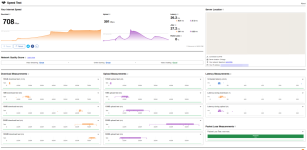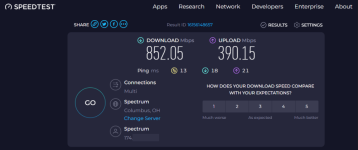Impressive. I think the majority of people would be happy if Spectrum just made something more than 35Mbps upload available to go along with insanely fast download speeds, in all areas. (Especially for businesses.) Even 300Mbps minimum speeds deserve more than 10Mbps upload. (Same issue for Xfinity.) Most people don't need symmetric speeds at these levels.
When you say same price, what did you have before and how much was it? I can't imagine they'll offer that widely without making it much more expensive for most people, except perhaps where they have solid competition from fiber providers. At my house, Spectrum 1G/35M here would only be $10 less than AT&T fiber 1G/1G would be. And I use WOW! where 1G/50M would be another $10 less than Spectrum's if I wanted it. (I'm on the 300M/20M plan, but I get nearly 40M upload.)
I completely agree. 35 Mbps was really a low bar especially for businesses. With so much in the cloud + backups, it's too little upload shared across 10, 20, 30+ people. Spectrum never got around to mid-split, so my sympathy is not easily forthcoming.
We don't need this much capacity, honestly—the only motivator for the gig plan
was faster uploads. The changes coming:
| Plan | Pre-high-split speeds | Post-high-split speeds |
| Spectrum Internet | 300 Mbps down / 10 Mbps up | 300 Mbps down / 300 Mbps up |
| Spectrum Internet Ultra | 500 Mbps down / 20 Mbps up | 500 Mbps down / 500 Mbps up |
| Spectrum Internet Gig | 1 Gbps down / 35 Mbps up | 1 Gbps down / 1 Gbps up |
We also have a few Spectrum Business accounts; in our area, high split for current Business customers will be available (opt-in-only again) by the end of April 2024.
//
Pricing: great question. We're halfway through a 2-year price promotion of $59.99 / month for this Internet Gig plan. We have FTTH now to our neighborhood, otherwise Spectrum never offered this price to us when we were customers for years and years.
Quite unfortunately for us, our fiber competitor (Metronet) was somehow much less reliable than Spectrum. It also had its own CGNAT & peering issues.
But, once Spectrum reverts to its non-promotional rate ($114.99 / month) for this plan, we'll happily downgrade to a 500 / 300 Mbps plan (which is already enough with high split) or, if Spectrum prices really much worse (e.g., currently high split is free, but will it be forever free?), we'll hop over to Metronet. Spectrum
could've done mid-split years ago.
//
How is the congestion and real-life speeds? For example, pushing large backup files up, or tunneling out to the internet via your home network via VPN from another fast network (which would stress your bandwidth in both directions)?
Having symmetrical bandwidth is big quality of life improvement, and not having that feels like a huge step backwards. Moving from dial-up to "broadband" was a game-changer in the 90s, and having symmetrical bandwidth is the next big step, IMHO.
I have Frontier (nee Verizon) FIOS 500/500 fiber, and having a fat upload has allowed me to do things I wasn't able to before. It made cloud-based backup services viable, I can use Plex remotely and it works very well even at high bit rates (I travel a ton, so this is nice), and using Wireguard via the home network is nearly seamless. Remote access into my network feels just like being on the LAN, but with a tad more latency depending on where I'm tunneling in from. I've had to upgrade my router from a Ubiquity USG-4 Pro to a DIY OPNSense setup to take advantage of the bandwidth without running into bottlenecks with the router's firewall.
I tried 1gb/1gb for a few months, but that was a barely noticeable improvement over 500/500, so I actually moved back to save ~$30/mo.
My backup connection (both spouse and I both work from home + after-school remote learning courses for the kids), at home is Spectrum (200/15? I think?) and that feels barely usable, in contrast to the FIOS, due to the choked down uploads, but Frontier's network is shoddy enough that it comes in handy a few times a year. Spectrum is shoddy around here, too, but the times they have issues don't overlap.
Great questions. So far, congestion doesn't seem to be an issue, but will run a test later this evening at peak times (~10pm) and share how it goes.
Uploading a 2.24GB video file to Google Drive took 107 seconds, so on average
168 Mbps. It starts slower at ~60 Mbps and then ramps to ~400 Mbps, but the ramp takes a bit of time. Some of this ramping could be a side effect of the CAKE shaping, too, but I'm with you: this level of bandwidth is gluttony and latency is more worthy of any optimization / improvements.
//
I agree; I didn't do gain much (except download updates faster, heh) with 1 Gig (vs 500Mbps or even 100 Mbps), but with upload, it's actually an interesting upgrade. I once had to remotely download a system image and it was hellish; I mean, two days (48hr+). Ideally, it won't be that bad this time.
But now, exactly: I can consider a VPN. I can consider streaming some of local cameras. I can absolutely do so many more backups that I've otherwise needed to replicate & move off-site here. I haven't even begun to imagine everything yet.
And, yes: we actually lucked out by running a J4125-based OpenWRT system here with a few 2.5 Gbe LAN / WAN ports. It was honestly overkill and thought to move off to a simpler system, but fate worked out here.
//
Agreed. I wouldn't mind downgrading to 300 or 500 in a heartbeat if it was cheaper (technically, leaving this current promotion actually makes those plans +$30 / m and +$45 / m more expensive, as they are non-promotional prices). But once this promotion ends, that'll be our first target. We just don't use the bandwidth enough now to basically throw away money and there isn't really any "peace of mind" as nothing we do ever
requires this much even on its worst days.
Yes. I also have been surprised that some fiber companies aren't as reliable as one would expect; I mean for a long time until now and likely in the foreseeable future, cable ISPs have made very few friends for consumers due to quality issues. Surely that'd be the best place to differentiate, after upload speeds.
//
Also - a minor note. Ookla Speedtest runs poory via browsers on my laptop. Inconsistent and I get lower speeds, even on business circuits that have guaranteed bandwidth. I've found that their apps (mobile and desktop) are much more accurate.
Well, what do you know, you were quite right. That earlier test was was on my desktop (wired, though thru 2 switches) with new-ishing Cat6 wiring, but on the browser. Switching to the Windows app and, voila, actually symmetrical:
I think I saw that pop-up a while ago to use the desktop app, but I forgot. And here was I, wrongly blaming something upstream. My apologies, Spectrum.
Thank you, kindly.













